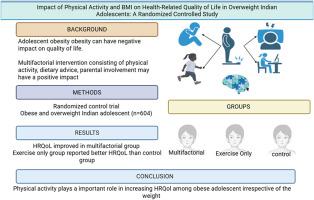Impact of physical activity and BMI on health-related quality of life in overweight Indian adolescents: A randomized controlled study
引用次数: 0
Abstract
Background
Health-related quality of life (HRQOL) is a critical yet often overlooked component of adolescent obesity management. While physical activity (PA) and body mass index (BMI) are established markers of health, their combined influence on HRQOL in Indian adolescents remains underexplored.
Objective
To examine how PA and BMI influence overall and domain-specific HRQOL in overweight and adolescents with obesity following a structured lifestyle program.
Methods
In this randomized controlled study, 604 adolescents (aged 11–16 years) with BMI above the 85th percentile were recruited from schools in Udupi, India. Individuals were randomized into three groups: multifactorial strategy (MFI: exercise, lifestyle education, behavioral counseling), exercise-only (EX), and Control group (CON). PA was measured using the Physical Activity Questionnaire for Adolescents (PAQ-A), and HRQOL was measured via the Pediatric Quality of Life Inventory (PedsQL 4.0). Linear mixed-effects models evaluated associations between PA, BMI, and HRQOL over a 12-month period, which included a 12-week intervention followed by 9 months of follow-up.
Results
PA was linked with better HRQOL in the MFI (β = 9.30, p < 0.001) and EX (β = 4.47, p < 0.001) groups. Interestingly, higher BMI correlated with better HRQOL scores in both program arms. The CON group showed no meaningful association between PA and HRQOL. The domain-level analysis found that PA and BMI were positively linked to physical, emotional, social, and school functioning in both program groups, with more pronounced effects in the MFI group. The CON group showed improvement only in emotional functioning related to BMI.
Conclusion
Structured PA programs, especially those combining education and behavioral support, notably enhance the quality of life among overweight Indian adolescents. These findings reinforce the importance of focusing not solely on weight loss, but on holistic, behavior-driven health outcomes in adolescent obesity care.
Clinical trial registration
CTRI/2019/04/018,834.

身体活动和BMI对超重印度青少年健康相关生活质量的影响:一项随机对照研究
背景:与健康相关的生活质量(HRQOL)是青少年肥胖管理中一个关键但经常被忽视的组成部分。虽然身体活动(PA)和身体质量指数(BMI)是公认的健康指标,但它们对印度青少年HRQOL的综合影响仍未得到充分探讨。目的探讨PA和BMI如何影响超重和青少年肥胖患者遵循结构化生活方式计划的整体和特定领域的HRQOL。方法在这项随机对照研究中,从印度Udupi的学校招募了体重指数高于85百分位的604名青少年(11-16岁)。个体被随机分为三组:多因素策略组(MFI:运动,生活方式教育,行为咨询),只运动组(EX)和对照组(CON)。使用青少年体育活动问卷(PAQ-A)测量PA,通过儿科生活质量量表(PedsQL 4.0)测量HRQOL。线性混合效应模型评估了12个月期间PA、BMI和HRQOL之间的关系,其中包括12周的干预和9个月的随访。结果在MFI组(β = 9.30, p < 0.001)和EX组(β = 4.47, p < 0.001)中,spa与较好的HRQOL相关。有趣的是,在两个项目组中,较高的BMI与较好的HRQOL评分相关。CON组PA与HRQOL之间无显著相关性。领域水平分析发现,在两个项目组中,PA和BMI与身体、情感、社会和学校功能呈正相关,在MFI组中效果更明显。CON组仅在与BMI相关的情绪功能上有所改善。结论结构化的PA项目,特别是那些将教育和行为支持相结合的项目,显著提高了印度超重青少年的生活质量。这些发现强调了在青少年肥胖护理中,不仅要关注减肥,还要关注整体的、行为驱动的健康结果的重要性。临床试验注册ctri /2019/04/018,834。
本文章由计算机程序翻译,如有差异,请以英文原文为准。
求助全文
约1分钟内获得全文
求助全文

 求助内容:
求助内容: 应助结果提醒方式:
应助结果提醒方式:


